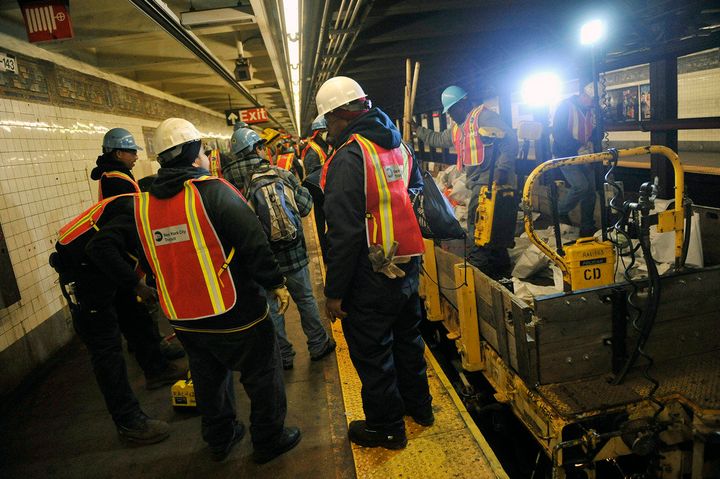
Three weeks have passed since Sandy. For most, life has returned to a pre-Sandy cadence. Attention at the national level, buffeted by the elections, the "fiscal-cliff" and sex-scandals, may be waning. Even at the local level, if your home was not damaged or lose power and if your piece of transit is up and running, Sandy seems a distant memory. Yet, it was a climate-scientist's nightmare-come-true: a most intense storm impacting a most densely-inhabited region. It left in its wake scores dead, thousands homeless and a devastated regional infrastructure. The very dark Sandy clouds may, still, have a silver lining, if the region and the nation come together to accept that the climate is changing, that we have to respond, and that an appropriate response will, likely, be time and resource-intensive. Acceptance will be easier, indeed desirable, if we look upon this not as a one-time fix but an ongoing process and as an opportunity -- one that will generate jobs, renew infrastructure and give the economy a future-friendly fillip.
Sandy shone a light on a well known, but not as well responded to fact -- that New York's infrastructure, crucially its public-transportation, is very old, over a century in parts and was built for a different world. Its unique 24/7/365 operations make even routine maintenance a big challenge. It is like an overcoat handed down through four generations and worn every day, yet never much more than patched when an elbow shows through. A system which went into service when the current riders' grandparents were yet unborn, it needs a larger infusion of resources than transit in New York has ever had. The scale of infusion requires political championing and popular consensus-building much beyond what an operating agency can muster.
Transit in New York needs comprehensive rejuvenation, not just patching of tattered edges. An overhaul including, but not limited to, building new lines that provide redundancy, creating new nodes to decongest existing ones, embracing new communication and train-control technologies that can increase frequency of service and so on. These interventions, unsurprisingly, require expensive new-construction and retrofitting of existing tunnels and stations. Secondary modes such as Bus Rapid Transit (buses with dedicated lanes) need to be extended (BRT should, however, not be thought of as panacea. A fully-loaded New York subway train, at peak hour, carries about 3,000 commuters and shows up every two minutes. A fully loaded articulated bus carries about 150 people. It is virtually impossible to emulate the throughput of subways with buses. BRT, ideally, functions secondarily to heavy-rail).
Specifically for climate change, the rejuvenation should accelerate the raising of ventilation infrastructure -- major flood vulnerability, retrofit older lines with flood gates and reenvision stations and tunnels in terms of every water vulnerable function that resides in them. Such a comprehensive overhaul of century-old infrastructure below the highest wage island in the world is not going to be cheap. The cost of inaction though, as we see in Sandy's wake, will outstrip cost of action. New lines are often criticized as very expensive ways to attract very few additional riders. This criticism misses the much bigger system-wide redundancy that this creates. That redundancy permits temporary shutting down of old lines, so they may be retrofitted or in the event of a big storm.
Interestingly, the answer to the question where this money is going to come from may lie within transit itself. Public transportation creates very carbon-efficient places. The average New Yorker has a carbon footprint that is approximately one quarter that of the average American. If the average American, magically, acquired a New Yorker's footprint, the national target of "80 by 50," i.e. reducing carbon footprints 80 percent by 2050, would be almost achieved! Yet, in the current system of accounting this incredible environmental benefit has no value. That public-transportation in New York is arguably America's single largest source of reducing emissions, amounts to nothing. Zero.
This is not true for other industries. Utilities routinely sell "green-power." The electron entering the green purchaser's home may be "brown," but her dollar goes toward enlarging the renewables market. Similarly, auto-makers sell hybrid cars for more than their non-hybrid versions (often, for more than would be justified by gas-savings alone). These industries, and many others, have figured out a way to decouple the basic service and the "greenness" of it and are pricing the two separately -- thereby creating a dollar-value for the "greenness."The transit industry too, has developed a reliable technique to quantify the (in the case of New York, millions of) metric tons of emissions that it helps avoid -- based on ridership. The quantification is independently verifiable. However, in the absence of lobbying muscle, this has not caught politicians' attention. If consensus could be reached on capturing the value of transit's greenness, it could generate a significant share of required resources.
There is not only a financial but also a poetic logic to tapping transit's environmental benefits to adapt for and to mitigate climate change. Good public transportation and climate change disrupt each other; we have only to choose which disruption we would rather have.
Projjal Dutta is the first ever director of sustainability initiatives at the Metropolitan Transportation Authority, NY State. He blogs at takingthecaroutofcarbon.tumblr.com